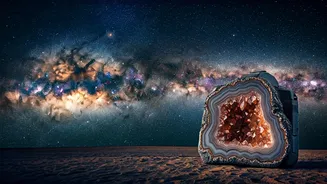Cosmic Timekeepers Examined
Determining the universe's age is a monumental scientific task. Scientists sought clues from multiple sources, using various methods to arrive at a consensus.
One primary method involved the analysis of the oldest rocks on Earth, which provided insights into the early history of our solar system. The principle relies on radiometric dating, a technique that measures the decay of radioactive isotopes within these rocks. By analyzing the proportion of parent isotopes to their decay products, researchers could calculate the time elapsed since the rock solidified. These ancient rocks served as cosmic timekeepers, offering a glimpse into the early conditions of our planetary neighborhood. Further, the oldest meteorites provided additional data, supporting the age estimates derived from terrestrial rocks and giving a more comprehensive picture of the solar system's formation.
Stellar Evolution's Clues
Beyond terrestrial and meteoritic clues, scientists looked at the stars themselves. The age of the oldest stars in our galaxy became another critical piece of the puzzle. Studying globular clusters, which are dense collections of stars, proved essential. By observing the luminosity and colors of stars in these clusters, astronomers could create 'Hertzsprung-Russell diagrams'. These diagrams illustrate a star's evolutionary stage, helping determine its age. The oldest stars in these clusters acted as indicators of the minimum age of the universe. The way these stars evolved gave important information. Further, understanding stellar evolution, particularly the stages of hydrogen fusion and the eventual red giant phases, aided scientists in refining the age estimates.
The Hubble Constant's Role
Scientists did not stop there; they also employed another important tool: the Hubble Constant. This constant, named after astronomer Edwin Hubble, is a measure of how fast the universe is expanding. By observing the redshift of distant galaxies, which reveals their recession velocity, and correlating it with their distance, scientists could calculate the expansion rate. Using this rate, along with the laws of physics, a determination of the universe's age was possible. The Hubble Constant helped establish the timescale of cosmic expansion. Determining the Hubble constant required significant observational efforts. Various techniques were developed to precisely measure distances to galaxies. These methods, including the use of standard candles like Cepheid variables and type Ia supernovae, provide the necessary data for calculating the Hubble constant and, by extension, the age of the universe.
Cosmic Microwave Background
Further, studying the Cosmic Microwave Background (CMB) also gave scientists more answers. The CMB, the afterglow of the Big Bang, offers another method to determine the universe's age. The CMB's properties, like its temperature variations, give important information. By measuring these variations and using theoretical models of the early universe, scientists can estimate how old the cosmos is. The CMB acts as a snapshot of the universe when it was very young. Analysis of the CMB involves complex data. Satellites like the Wilkinson Microwave Anisotropy Probe (WMAP) and the Planck satellite have collected data on the CMB with amazing precision. These observations have given very accurate measurements of the universe's age, reinforcing other methods and improving our understanding of cosmic history.
Consensus and Accuracy
Through these varied techniques, scientists arrived at a consensus: the universe is approximately 13.8 billion years old. However, this estimate is not static; it continues to evolve as new data emerges. Technological and observational improvements allow for greater accuracy. Refinements in the Hubble Constant, CMB studies, and stellar age estimations continuously fine-tune the understanding of the universe's timeline. The remarkable convergence of these independent methods offers strong support for the current estimate. Further, continued research is essential for addressing uncertainties and improving the understanding of the cosmos. Ongoing advancements, such as the development of advanced telescopes and sophisticated data analysis techniques, will continue to contribute.





